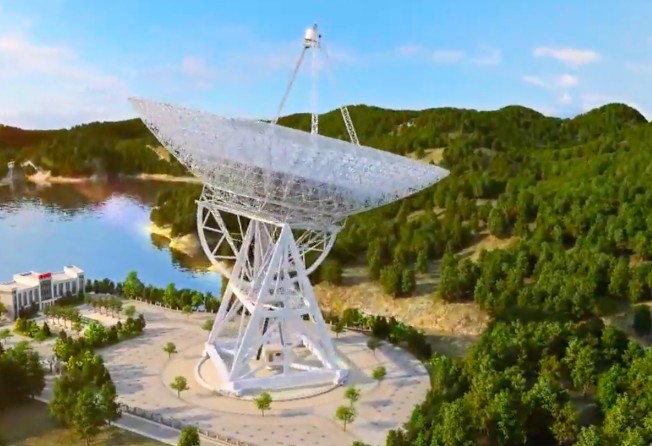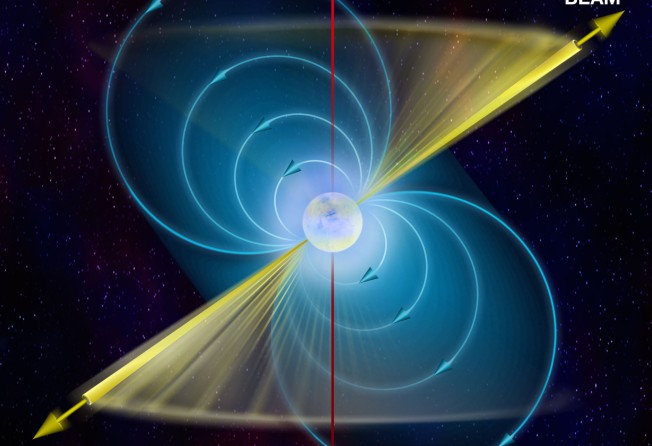
02:10
Nasa hits target asteroid in Earth-defence test

China is set to start building what will be the planet’s largest steerable radio telescope, with a massive dish 120 metres (394 feet) in diameter to provide high-precision time keeping, as well as a cutting-edge tool for fundamental research.
The 350 million-yuan (US$48 million) Jingdong Radio Telescope (JRT) will be located in the mountains of southern China’s Yunnan province.
Once it is operating in 2026, it will measure the passage of time by monitoring highly regular radio pulses emitted by pulsars, a type of fast-spinning neutron star known as the most accurate clock in the universe.
Along with the Five-hundred-metre Aperture Spherical Telescope (FAST) in Guizhou province, the Jingdong facility will help China develop a pulsar-based timescale that is independent of – and more accurate than – the international atomic time service the world has relied on, according to Wang Min, the project’s chief scientist.
Wang, from the Chinese Academy of Sciences’ Yunnan Observatories in Kunming, said the project would also boost China’s leadership in radio astronomy and provide pulsar-based positioning and navigation for future Chinese spacecraft exploring deep space.
Pulsars are extremely dense, magnetised neutron stars that form when massive stars collapse at the end of their life. According to Nasa, a teaspoon of a pulsar on Earth would weigh as much as a mountain.
As pulsars spin, their radiation beams sweep past Earth like a lighthouse, and because they are extremely dense, they have very stable rotation periods, which make them very useful tools for scientists.
The idea of building a very large radio telescope dedicated to studying pulsars first took shape in 2013, Wang said.
After years of searching, Wang and his team found an ideal site for the telescope in Jingdong county. At 2,500 metres (8,200 feet) above sea level, Jindong’s Ailao Mountain nature reserve is nearly free of human-generated radio noise.
“More importantly, its proximity to the equator means better access to pulsars in the skies of the southern hemisphere,” he said.

Radio telescopes allow astronomers to see space in a way that is invisible to conventional optical telescopes.
The JRT will be able to see some 3,000 pulsars – hundreds more compared to similar-sized facilities, such as the Effelsberg telescope in Germany and the Green Bank telescope in the United States.
Wang said the plan was to observe more than 100 “millisecond pulsars” which rotate hundreds of times per second. Scientists will then choose 80 of the most stable candidates to establish a network, and measure and compare the arrival times of their pulses.
The goal is to improve how time is kept on Earth. While the international time service is based on about 400 highly precise atomic clocks, a pulsar-based timing system has a longer-term competitive advantage, since neutron stars can rotate with incredible stability for decades or longer.
So far, Scientists have used 18 millisecond pulsars and five large radio telescopes located across Europe to show that such systems could work.
Wang said China’s system would consist of three massive telescopes – the JRT, the 110-metre Qitai radio telescope being built in Xinjiang, and the FAST telescope in Guizhou.
The system will also help detect gravitational waves, which resulted when supermassive black holes merged in the early universe, generating low-frequency radio waves that distorted the fabric of space-time as they spread.

When such waves pass by Earth slightly altering its position, an array of pulsars – if accurate enough – could detect the change because the arrival times of their signals would change. “Pulsar arrays are the only way we know, so far, how to detect gravitational waves at nanohertz frequencies,” Wang said.
Meanwhile, Wang said designers would face major structural challenges to build the 3,400-tonne JRT. Other key technologies include the design and development of an ultra-wideband feed and low-noise receiver, which the team has been working on since 2020.
Building the telescope would strengthen China’s reputation in large-scale machinery design and processing, automatic control, low-temperature electronics, and system integration, he added.
“We look forward to finishing the construction in time, and sharing observational data with the global scientific community in the future,” Wang said.
The construction of the telescope will strengthen China’s muscle in large-scale machinery design and processing, automatic control, low-temperature electronics, and system integration, he added.